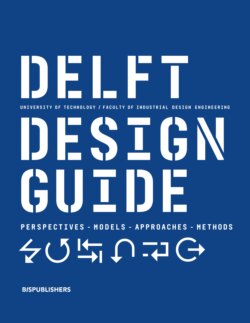Читать книгу Delft Design Guide -Revised edition - Annemiek van Boeijen - Страница 28
На сайте Литреса книга снята с продажи.
Оглавление22. Design for Emotion
How? You can use existing models, approaches, and methods, but often they need to be attuned to the local context. For example, you need to adjust participative methods to the targeted culture (see Culture-Sensitive Design). When designing for a BoP context and emerging markets, pay extra attention to the following principles:
--------
Affordability: The challenge for you as a designer is to propose affordable solutions. There are several strategies to make products cheap, but overall a holistic approach is needed. You need to take into account not only the production costs of a single product but also the entire system so that each actor or component can benefit from the new product, including entrepreneurs.
--------
Accessibility: The solution should be acces- sible to the intended users, especially those living in areas with poor infrastructure.
--------
Availability: If the products are manufac- tured locally, the availability of materials and skills should be taken into account.
--------
Reliability: Solutions should be reliable and easy to maintain and to repair locally; this is to prevent people from becoming too dependent on outsiders.
--------
Sustainability: Solutions need to be sustainable and should not harm the often vulnerable living environments.
--------
Acceptability: You must have a thorough understanding of the opportunities and preferences of the targeted people, the intended users and other people that are influenced by your design. Realising they are both members of a cultural group and members of the global community.
--------
These principles are part of an integrated, holistic, and multi-disciplinary design approach that stimulates local and inter- national entrepreneurship.
Design for The Majority
What & Why? Most products are designed for the top of the world’s economic pyramid (ToP). These products are unsuitable for the majority of the world’s population, who from an economical perspective belong to the Base of the Pyramid (BoP). ToP products are typically too expensive, unavailable for people living in poor areas, and are often not appropriated enough to local situations and possibilities. Designers are often not familiar with the socio-economic context of the BoP population. They need thorough contextual research to gain an empathic understanding of the intended users and context of use. Another major challenge in designing for the BoP context is the variety and complexity of the stakeholder landscape. Such projects often involve not only a company but also governmental and non-governmental organisations, aid foundations, and knowledge institutes, all with different backgrounds and interests.
-------------------------------------------------------------------------------------------------------------------
Mindset: Designers working for BoP projects believe that welfare and well-being should be distributed more equally worldwide. When designing for unfamiliar contexts, you need an open attitude – at least open enough to question your own presumptions about what the norm is, what design should do, and what good design is. Furthermore, you need to prepare yourself for uncertain and unexpected situations and be flexible enough to deal with them.
-------------------------------------------------------------------------------------------------------------------
References & Further Reading: Jansen, G.J. & Crul, M.R.M., 2012. Sustainable Product Innovation: A Do-it-yourself Toolkit for SMEs in Emerging Economies . Delft: Delft University of Technology. / Kandachar, P.H., de Jongh, I. & Diehl, J.C., 2009. Designing for Emerging Markets- Design of Products and Services . Delft: Delft University of Technology. / van Boeijen, A.G.C., 2015. Crossing Cultural Chasms: Towards a culture- conscious approach to design . Doctoral Thesis, Delft University of Technology, Delft. / Mink, A. 2017. Design for Well-Being: An Approach for Understanding Users’ Lives in Design for Development. Doctoral thesis, Delft University of Technology.
Tips & Concerns
As an ‘outsider’, you need to do your homework first! The way people live and behave is usually based on a long history. Before you intervene, it is important to understand the intrinsic reasons of why people do what they do.
--------
Additional aspects that should be taken into account include building trust, understanding otherness, checking biases, and dealing with poor infrastructure. So you will need more time than what you may be used to.
--------
Contextual design research methods should be attuned to the local context.
--------
For organisations in BoP contexts, producing for Western markets often involve another interpretation of requirements such as product quality, consumer preferences, and safety.
--------
For a good understanding of the local situation, you need to experience the local context yourself.
--------
The world is rapidly changing. Concepts such as ‘developing countries’ and ‘East versus West’ are becoming outdated, and they do not reflect nor justify reality.
-------------------------------------
Limitations
The success of a product or service depends on many factors, and many new designs simply do not enter the market. It is especially difficult in the BoP context, and therefore the collaboration with local and experienced people is important.
Design for The Majority means designing products and product- service systems for the world’s less fortunate people. Often these people live in nations with emerging markets that are characterised by rapidly growing production and consumption.
perspectives
---------------------------------------------------------------------------------------------------------------------------------------------------------------
27
